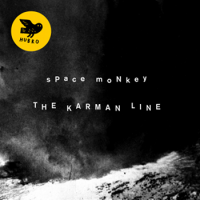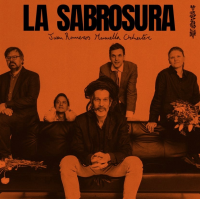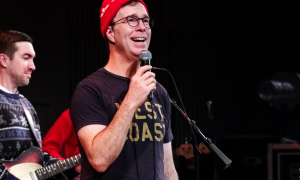Home » Jazz Articles » Live Review » North Sea Jazz Festival 2014
North Sea Jazz Festival 2014

Rotterdam, Netherlands
July, 11, 2014
The North Sea Jazz Festival in Rotterdam is the biggest indoor festival in Europe. It is organized by Mojo Concerts and The Security Company, both part of Live Nation Entertainment, a worldwide operating live event mega-organizer (240,000 events annually in 33 countries).
The amount of parallel concerts and big names in three days and nights— starting in the late afternoon—is dizzying. It also evokes a constant desire to see everything, to be somewhere else and hence be on the run permanently. It is a festival that is overcrowded nearly everywhere. It is the biggest indoor festival in Europe but has the smallest, ugliest press room ever experienced in festivals around the world.
But you are not forced into a lot of less pleasant things at such mega festivals. You can decide to focus and concentrate on a few quality things if you can find them in the programming. A key factor is the hall, just, too. It just so happened that this year's edition had an attractive program in the Madeira hall on the first festival day. The Madeira hall is the best hall in the festival building: good view; not too big; never overcrowded; and acceptable acoustics.
Madeira had four concerts in a row on the first festival day, with an intermission of 30 minutes between each concert: the premiere performance of the festival's annual commissioned composition; Henry Threadgill's Zooid; Ambrose Akinmusire Quintet featuring Theo Bleckmann; and the Jamie Baum Septet+. Attending all the concerts in a row and ignoring the rest of the festival program completely seemed to be an attractive option and worthwhile trying.
Tony Roe
The festival's annual composition commission—which was actually funded by the Dutch Fund For The Performing Arts—was assigned to young pianist Tony Roe (pronounced Roo). Roe is an ambitious young musician who is very much into reinventing, restructuring and redefining modes of staging music via multimedia deployment and an interdisciplinary approach. His group, Tin Men and the Telephone, has worked on and developed a series of multimedia applications in the past that, amongst other things, allowed audiences to intervene actively, by means of digital devices, into the performance of his piano trio. The group has also used devices to manipulate the matching of music and pictures, and piano keys and letters, or generate music from the sound of everyday surroundings. It was a game-oriented, audience-pleasing setup. The new commissioned work with a new lineup, however, was revealed as an audience-challenging work.
In the presented work, Roe's efforts were strictly confined to and focused on the manipulation of the musical material and form itself, its unfolding and the role of the musicians and a dancer in the performance process. The musical material and form was digitally manipulated by means of and in interaction with visuals and electronic sounds. Roe performed his multidimensional composition with three high calibre string players—cellist Jorg Brinkmann, violinist Jeffery Brunsma and violist Oene Van Geel —plus well- known reed multi-instrumentalist Joris Roelofs on bass clarinet, Marcel Wiercks on electronics and dancer Kenzo Kusuda.
Roe made use of visuals on both sides of the ensemble. Initially, the visuals were embellishments of the music, as is common these days. Later on, playful pointed disparity of music, musicians and visuals arose. The shadow of an individual musician or the dancer appeared onscreen like in Indonesian Wajang puppet theater, but the musicians' gestures onscreen and the real-time music played by the real musician onstage were not synchronized. This caused a sensation of conflict, disturbance and need of (mental) readjustment musically and visually. Ongoing variation of disparate mappings evoked an effect that could be compared to René Margritte's famous mirror-painting, La Réproduction Interdite, a playful failure of mirroring. The procedure opened up a lot of musical possibilities of improvisational "failing mirroring" and labyrinthine structure. For dancer Kenzo Kusuda, it also provided lots of counteracting possibilities. Kusuda constantly acted as a mime and a dancer, (re)combining gaze and body movement in significant ways. All elements together evoked a higher level of awareness and a constructivist way of listening.
The work included some pre-structured parts to start with and to return to. In- between, it had parts that were executed by means of manipulation of and improvisation on matches of interacting visual and audio samples. Maybe due to the complexity of mirroring effects the scored parts of the music were more on the safe side. In Roe's work not only preconceived form or themes were reshaped as usual by means of improvisation; instead, the perception and reception of the audience was shaken up and scrambled, which was a way of emphatically inciting and turning the audience to their own recreations of the elements with which they were confronted. The excitement of such an approach depends on the aesthetic and dramaturgical qualities of the design and its execution. The musicians all played on a high, fine-tuned level, the performance had a good flow and remained stimulating throughout. Evidently the performance of a work like this requires facilities in terms of screens as well as sound and light design. What the festival provided in this respect, for a commissioned work of its own, alas, was clearly not up to the mark. It deserved more and better.
Roe made use of a series of challenging elements, such as the Wajang-like shadow- pictures (of musicians) or fragmented eye images. By showing the picture of an eye and manipulating it electronically, the visual element was, itself, commenting. It was additionally augmented or counterbalanced by a vocalized textual element referring to eyebrow makeup. This vocalized element was fabricated in cut-up technique (Brion Gysin/William S. Burroughs), resulting in fragmented speech flow. Thus the performance contained a cascade of self- referential devices made up to escape the aesthetic reality it produced. The eye image was reminiscent of the famous self-referential eye image of the short silent movie, Le Chien Andalou (1928), made by Luis Buñuel and Salvador Dalí. It seemed that Roe feels a strong urge to go on with this work and lineup to exploit and refine its potentials. It can only be cheered!
Henry Threadgill's Zooid
Relaxed and in an extraordinarily good mood, the great Henry Threadgill entered the stage in Rotterdam together with the four musicians of his Zooid ensemble of nearly 15 years: tubaist Jose Davila, guitarist Liberty Ellman, cellist Christopher Hoffman and drummer Elliot Humberto Kavee.
Threadgill is one of the most important and original composers of contemporary jazz. As a composer he has developed over the decades a highly sophisticated own system of music and compositional strategies. The music is intensively studied, developed, rehearsed and performed by this ensemble. His music is deeply based in the roots of Afro-American music (from the Gulf- area in the American south), the key elements of which he has incorporated and transformed as part of a fascinating cyclical form of a perpetually mobile kind of music. A performance can be very dense and demanding but also very light, the latter very much in accordance with his approach as it turned out right at the start of the concert. Threadgill played a wonderful "flying" piece with a bossa feel—of course, entangled in his circling system. He finished with a great staggering two-minute waltz as an encore. In-between, lots of pure beauty with an alto piece reminiscent of the intensity of the great Arthur Blythe. The audience appeared utterly delighted by the concert.
Ambrose Akinmusire Quintet featuring Theo Bleckmann
In addition to Tony Roe, American trumpeter Ambrose Akinmusire entered the Madeira stage as an award-winner. He received the festival's annual Paul Acket Award, donated by BNP Paribas bank and endowed with $7,000. Past award-winners have been Anat Cohen, Craig Taborn and Arve Henriksen. A strangely clumsy award presentation fostered a welcome quick return to the music. Akinmusire was a self-conscious young musician who did not need to push himself into the foreground. He was more observant, and fostered the interplay of his band's musicians. His trademark is a full deep tone from which he can whizz into high register tones very quickly, if functional and necessary. His tone, use of registers and dynamics shared some of the characteristics of the great Bill Dixon, one of the key figures of the New York avant-garde in the 1960s and '70s.
Akinmusire's group, consisting of saxophonist Walter Smith III, pianist Sam Harris, bassist Harish Raghavan and drummer Justin Brown, played sophisticated, far-reaching lines with wonderful tension-and- release patterns. The quintet also performed some beautiful balladeering. In most of the pieces, the group transcended known patterns without throwing away too much. The collaboration with vocalist Theo Bleckmann clearly fit in and represented a bold step to expand the music even further.
Bleckmann—a high-profile vocalist and singer who has worked with the likes of Meredith Monk, Uri Caine and John Hollenbeck—is no ordinary or straightforward jazz singer. His voice has a very distinguished timbre and he has the ability to curve with his voice like a figure skater, which often allows him to use his voice more like an instrumentalist. This became manifest time and again in Akinmusire's fully confluent trumpet-voice- sax-frontline. To achieve that seemed a special talent of Akinmusire as a leader. It was remarkable because his instrument, the trumpet, is often used in a different, more dominant way. Akinmusire has developed a musically well-grounded and differentiating approach. It revealed that Akinmusire possesses the talent to allow space for strong contributions like Bleckmann's to fully unfold in an even stronger framework. Maybe that is what was meant in the festival's program notes, which said that Akinmusire is "an American trumpeter who has developed his own unique musical style by being exposed to dynamic ways of playing and collaborating with musicians with varied experiences."
Jamie Baum Septet +
Flautist Jamie Baum, the leader of the final group of the night was another award-winner. She recently received a Guggenheim composition award, together with Steve Coleman and Elliot Sharp.
The extended Jamie Baum septet, a nine-piece ensemble—existing now for more than eight years—was clearly a group of special shape and sound, with leader Baum joined by alto saxophonist/bass clarinetist Douglas Yates, trumpeter Russ Johnson, and French hornist Chris Komer on the front line; guitarist Brad Shepik and pianist John Escreet; plus three musicians that were the group's heartbeat—double bassist Francois Moutin, drummer Jeff Hirshfield and tablaist Dan Weiss. Having seen this remarkable group at the North Sea Jazz Festival, it was even more remarkable that this group was not programmed by other European festivals. The ensemble played music of serene translucent spaciousness, suffused by richly swirling and fluttering instrumental colors. At first listen, the ensemble's abundant sound, its light flow and gently (pro)pulsing rhythmical undercurrent felt familiar, like a warm breeze, but also radiated a kind of remote arcane sensation still carefully to be uncovered. Gradually this was revealed in the second piece that appeared to have been designed after "Sweet Pain," a song by famous sufi-singer Nusrat Ali Khan. Later, some other transformed Khan songs (from his albums Nightsongs and Mustt Mustt) followed. The way Baum transformed and subtly inscribed characteristics of Khan's music into her ensemble's music appeared to be of a distinguished quality. The characteristics of Khan's music could be sensed clearly throughout, without ever becoming dominant or rendering the music overtly exotic, imitative or plundered.
When listening in detail, certain elements of Indian or Latin music could be discerned, but they disappeared in and were engrossed by the intricate structures and rich textures, rather focused listening. The most recognizable cues came from Shepik and Jamie Baum—and, of course, the tabla from well-known drummer Dan Weiss. All are experienced in Oriental and Indian music, but strictly avoided imitating or faking exotic styles. They played with a real feel for it and focused on the transformation and coloring of Baum's compositions, as in the group's version of "The Meeting" (with a stunning high register pizzicato by Moutin) and "The Game" (from Mustt Mustt). The intriguing entanglement of spare pellucidity, intense rhythmical undercurrent and inner perpetual rotation brought to mind the music of Gil Evans.
Besides Baum's great blending of voices in the collective sound of the ensemble, there were some memorable individual moments; "Monkeys of Gokarna Forest" seemed tailor- made for Escreet, a piece that referred to a siege by a troop of monkeys during a tour stop at Nepal's Katmandu Jazz Festival. There were more significant moments for Escreet, as we'll as for other players, all demonstrating the remarkably strong intercommunion that this group has achieved.
It was a stroke of luck that the programmers of the festival not only recognized the extraordinary quality of the ensemble but finally also booked it. The festival would make a still stronger mark in favor of artistic quality if something like this could not only be carefully programmed in a quality hall, as it was, but also highlighted even more firmly as a special part of the festival that is clearly visible to its visitors.
Photo by Henning Bolte
Tags
Jamie Baum Septet+
Live Reviews
Jamie Baum
Henning Bolte
Netherlands
Rotterdam
Henry Threadgill
Ambrose Akinmusire
Theo Bleckmann
Jamie Baum
Tony Roe
Tin Men And The Telephone
Jorg Brinkmann
Jeffery Brunsma
Oene van Geel
Joris Roelofs
Marcel Wiercks
Jose Davila
Liberty Ellman
Christopher Hoffman
Elliot Humberto Kavee
Arthur Blythe
ambrose akinmusire
Anat Cohen
Craig Taborn
Arve Henriksen
Bill Dixon
Walter Smith III
Sam Harris
Harish Raghavan
Justin Brown
Meredith Monk
Uri Caine
John Hollenbeck
Steve Coleman
Elliot Sharp
Douglas Yates
Russ Johnson
Chris Komer
Brad Shepik
John Escreet
Francois Moutin
Jeff Hirshfield
Dan Weiss
Gil Evans
PREVIOUS / NEXT
Jamie Baum Concerts
Support All About Jazz
 All About Jazz has been a pillar of jazz since 1995, championing it as an art form and, more importantly, supporting the musicians who make it. Our enduring commitment has made "AAJ" one of the most culturally important websites of its kind, read by hundreds of thousands of fans, musicians and industry figures every month.
All About Jazz has been a pillar of jazz since 1995, championing it as an art form and, more importantly, supporting the musicians who make it. Our enduring commitment has made "AAJ" one of the most culturally important websites of its kind, read by hundreds of thousands of fans, musicians and industry figures every month.


























